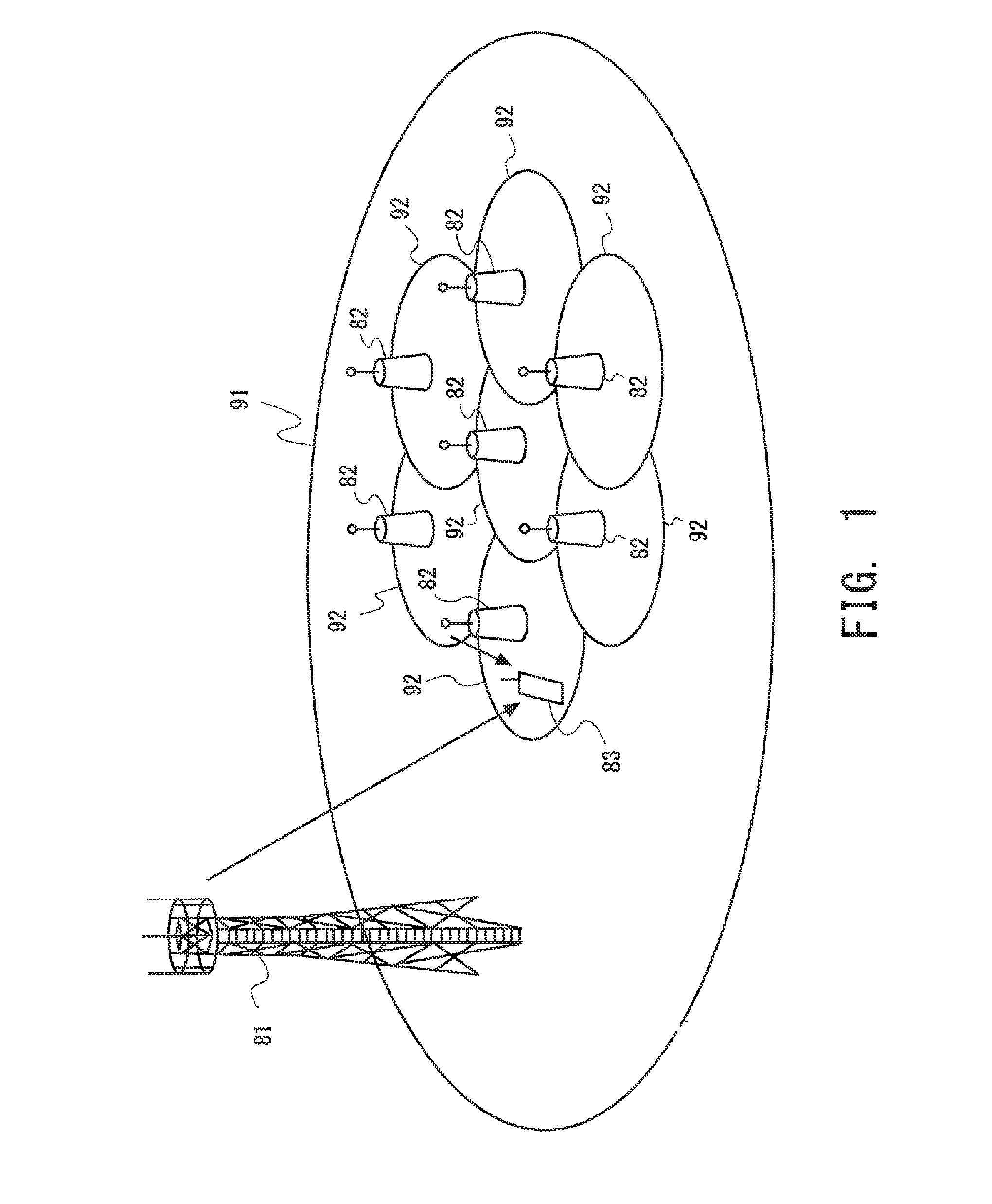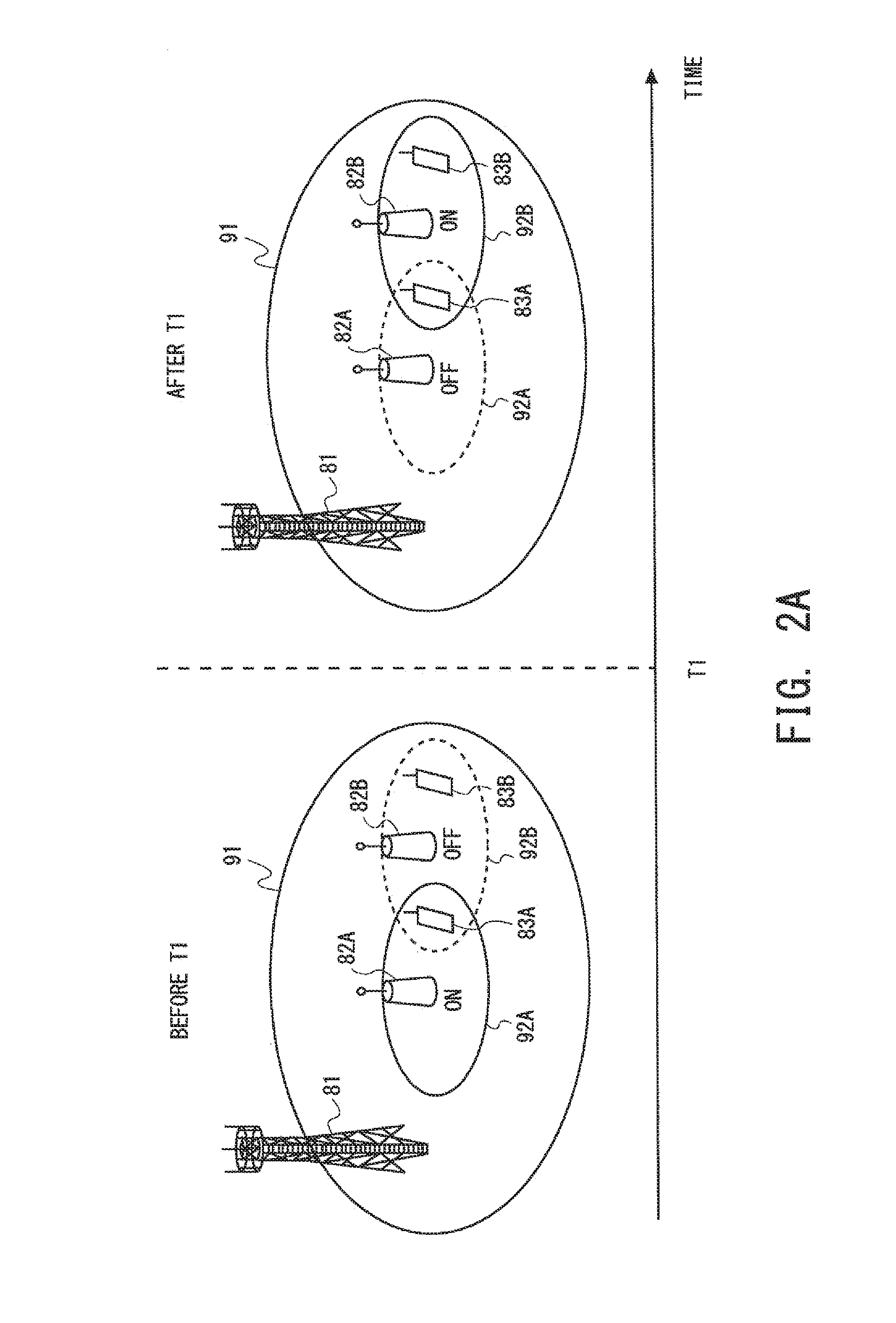Discovery period configuration for small cell on/off
a technology of discovery period and small cell, applied in the field of small cell on/off techniques, can solve the problems of time-consuming initial scell configuration, and achieve the effect of reducing traffic delay
- Summary
- Abstract
- Description
- Claims
- Application Information
AI Technical Summary
Benefits of technology
Problems solved by technology
Method used
Image
Examples
first embodiment
[0051]FIG. 5A conceptually illustrates an example of small cell ON / OFF behavior of the LPN 2 according to a first embodiment, where a network has already semi-statically configured the time T1 when the LPN 2A is being turned from ON to OFF and the LPN 2B is being turned from OFF to ON for user data transmission / reception. FIG. 5B shows a timing diagram illustrating operations of the MeNB 1, the LPNs 2A and 2B, and the UE 3A corresponding to FIG. 5A. The UE 3A in FIGS. 5A and 5B is in RRC_CONNECTED mode with the macro cell 10, controlled by the MeNB 1, as PCell and also served by the small cell 20A, controlled by the LPN 2A, as SCell during the ON period of the LPN 2A.
[0052]The Network configures the length DELTA.TD of the discovery period for the LPN 2B before the time T1. Note that, in drawings, “DELTA.” is denoted by the Greek letter delta. The discovery period is defined as a previous time period adjacent to the ON period. In other words, the discovery period immediately follows ...
second embodiment
[0059]FIG. 8A conceptually illustrates an example of small cell ON / OFF behavior of the LPN 2 according to a second embodiment, where the network has already semi-statically configured the time T1 when the LPN 2A is being turned from ON to OFF and the LPN 2B is being turned from OFF to ON for user data transmission / reception. FIG. 8B shows a timing diagram illustrating operations of the MeNB 1, the LPNs 2A and 2B, and the UE 3B corresponding to FIG. 8A. The UE 3B in FIGS. 8A and 8B is inter-eNB CA-capable and in RRC_CONNECTED mode with the macro cell 10, controlled by the Macro eNB, as PCell, but no SCell for the UE 3B is configured before T1. The network configures the discovery period of DELTA.TD for the LPN 2B before the time T1, which is same as that of the first embodiment. Different from UE 3A in FIGS. 5A and 5B, the UE 3B is firstly configured a SCell by the MeNB 1, and therefore the network only configure a new SCell of the LPN 2B. The detailed procedure is described as follo...
third embodiment
[0065]This embodiment illustrates a modification of the above-mentioned first and second embodiments. FIG. 10A conceptually illustrates an example of small cell ON / OFF behavior of the LPN 2 according to the third embodiment, where the network dynamically decided the time T1 when the LPN 2 is being turned from OFF to ON for user data transmission / reception. FIG. 10B shows a timing diagram illustrating operations of the MeNB 1 and the LPN 2 corresponding to FIG. 10A. The network may decide to turn on the LPN 2 based on, for example, traffic load at the MeNB 1, or traffic load at an LPN(s) adjacent to the LPN 2. The network, which dynamically decides the time T1 applied on the LPN 2, may include at least one of the MeNB 1, an LPN gateway (not shown), and an OAM system (not shown).
[0066]Returning to FIGS. 10A and 10B, the time T1 is defined as T1=T0+DELTA.TD by assuming the configured discovery period of DELTA.TD and the time T0 that is the starting time of the discovery period. How to ...
PUM
 Login to View More
Login to View More Abstract
Description
Claims
Application Information
 Login to View More
Login to View More - R&D
- Intellectual Property
- Life Sciences
- Materials
- Tech Scout
- Unparalleled Data Quality
- Higher Quality Content
- 60% Fewer Hallucinations
Browse by: Latest US Patents, China's latest patents, Technical Efficacy Thesaurus, Application Domain, Technology Topic, Popular Technical Reports.
© 2025 PatSnap. All rights reserved.Legal|Privacy policy|Modern Slavery Act Transparency Statement|Sitemap|About US| Contact US: help@patsnap.com



